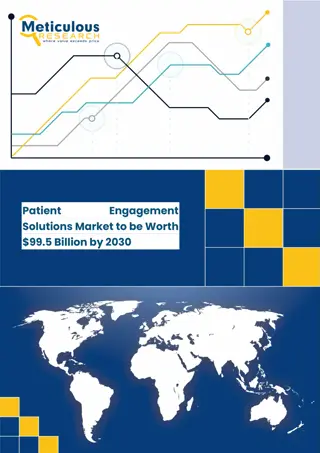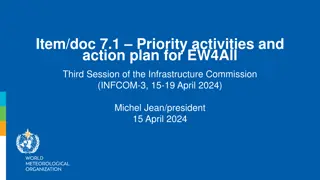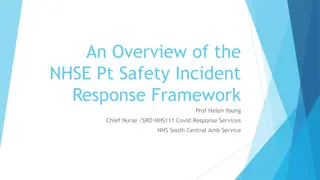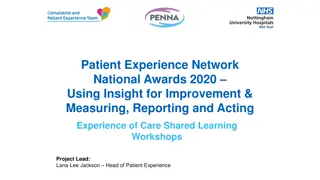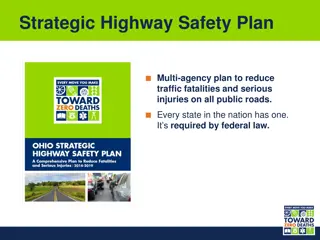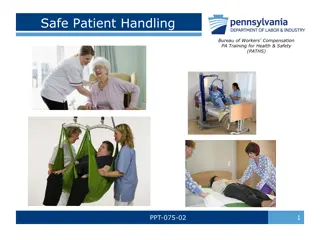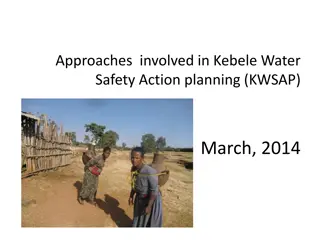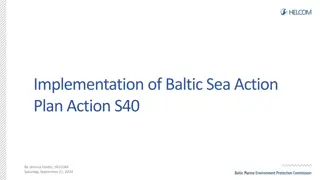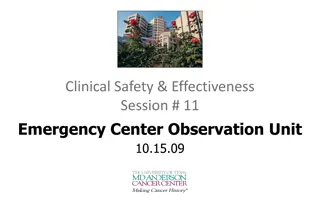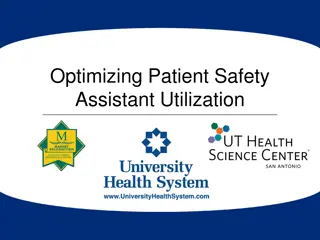Enhancing Patient Safety: Global Action Plan 2021-2030
Patient safety is a critical aspect of healthcare with millions of adverse events occurring annually. The Global Patient Safety Action Plan (GPSAP) for 2021-2030 focuses on key areas such as policies for zero patient harm, high reliability systems, safety of clinical processes, patient and family engagement, health worker education, information and research, and more. This plan addresses the burden of unsafe care, aiming to reduce harm and enhance the quality of healthcare worldwide.
Download Presentation

Please find below an Image/Link to download the presentation.
The content on the website is provided AS IS for your information and personal use only. It may not be sold, licensed, or shared on other websites without obtaining consent from the author. Download presentation by click this link. If you encounter any issues during the download, it is possible that the publisher has removed the file from their server.
E N D
Presentation Transcript
1st Virtual African Patients Congress: Co- creating Better Healthcare Systems (20 - 21 July 2021) AFRICAN PATIENT ENGAGEMENT IN THE GLOBAL PATIENT SAFETY ACTION PLAN 2021-2030 Dr Gertrude Sika Avortri (World Health Organisation: ISD/PHC; IST/ESA Harare Zimbabwe)
Presentation outline What is patient safety? Patient safety where are we? The global patient safety action plan 2021-2030. Patient for patient safety GPSP strategy 4: patient and family engagement. Action points for WHO, Member state, partners Action Points- WHO AFRO, Member states, partners
What is patient safety? is a framework of organized activities that creates cultures, processes, procedures, technologies and environments in health care that consistently and sustainably lower risks, reduce the occurrence of avoidable harm, make error less likely and reduce impact of harm when it does occur. behaviours,
134 million adverse events occurring annually due to unsafe care in hospitals, contributing to around 2.6 million deaths An average of one in 10 patients is subject to an adverse event while receiving hospital care in high- income countries while the figure for Low- and middle-income countries (LMIC) is about one in four Patient safety: burden? Globally, the cost associated with medication errors has been estimated at US$ 42 billion annually, not counting lost wages and productivity or increased health care costs Overall, 60% of deaths in LMICs from conditions amenable to health care are due to unsafe and poor- quality care
The Global Patient Safety Action Plan (GPSAP) 2021-2030 1. Policies for zero patient harm 2. High reliability systems 3. Safety of clinical processes 4. Patient and family engagement 5. Health worker education, skills and safety 6. Information and research 7. Synergy, partnership and solidarity
Centrality of Patient Safety Staffing & Personnel Safety Childbirth and immunization Mental Health Quality and Accreditation Infectious Diseases Clinical Services organization Non- Communicable Diseases Processes Programmes Infection prevention & Control Medication Safety Products Population WASH Medical Device Safety Safe Primary Care Blood Safety Radiation Safety
GPSAP Strategic objective 4: Patient and family engagement Strategy 4.1: Co-development of policies and programmes with patients Strategy 4.2: Learning from patient experience for safety improvement Strategy 4.3: Capacity building of patient advocates and patient safety champions Strategy 4.5: Information and education for patient and families Strategy 4.4: Patient safety incident disclosure to victims
Patient for patient Safety (PFPS) PFPS is one of the original action areas of WHO Patient Safety, established at the first PFPS workshop in November 2005. Initiative aims to promote active patient involvement in the programme and patient safety work worldwide. PFPS is building an international network of patients and family members who have experienced preventable harm, patient advocates, policy makers and health care providers to improving patient safety through partnership.
Adapt the Global Patient Safety action plan to the regional context and develop operational plan for implementation. Regional plan will delineate interventions and how to operationalize the five patient and family engagement components Action points: WHO Regional Office Facilitate network of Africa Patient and Family for patient safety that will offer platform for interaction, exchange of experience, challenges and best practices. Map and foster network of patient safety agencies & organizations working with patient associations for patient safety and focus areas. Promote effective collaborative work in the strategic areas- joint planning, resource mobilization and implementation.
Action points: WHO Regional Office Support and provide technical assistance Member States to translate the GPS action plan into actions: Advocate for patient safety revitalization. Determine baseline data/information. Develop national policy & strategies, strengthen coordination of patient safety programme at all levels, including resource mobilization. Train HCWs and patients advocates Facilitate measures for learning and experience sharing/dissemination. Put in place system to monitor patient safety implementation (e.g., annual regional webinar on patient safety) Support patient for patient safety associations
Recognize patient safety as a strategic health priority in health sector policies and programmes, making it an essential component for strengthening health care systems in order to achieve UHC Plan to implement global action recommendations tailored to the country context: Establish a national patient safety programme Action points: Member States Policy, strategy, institutional framework and action plan Advocate and commit to issues of patient safety in healthcare Identify and work with local private sector and patient groups and organizations. Plan for the celebration of World Patient Safety Day 17 September 2021, communication on announcement has been sent to all countries. Share plan plus TA for the celebration through the country WHO office
Advocate for patient safety as a strategic priority for Member States and health care organizations. Advocate Way forward: partners & other stakeholders Engage with professional organizations and patient organizations to develop and implement the patient safety goals, objectives and values Engage Participate in and be more proactive, support and facilitate patient safety programmes at local, national, regional and global levels Participate
Thank you Merci Obligado







